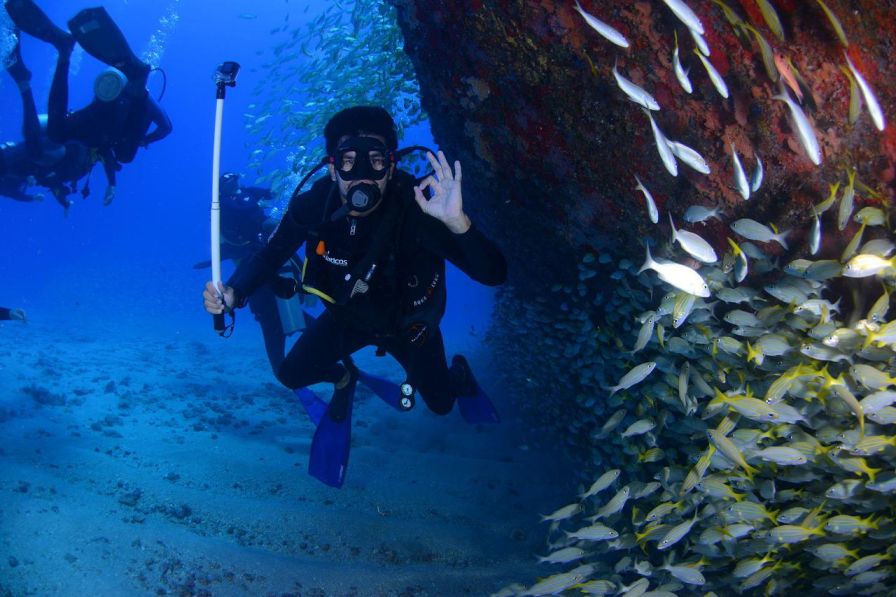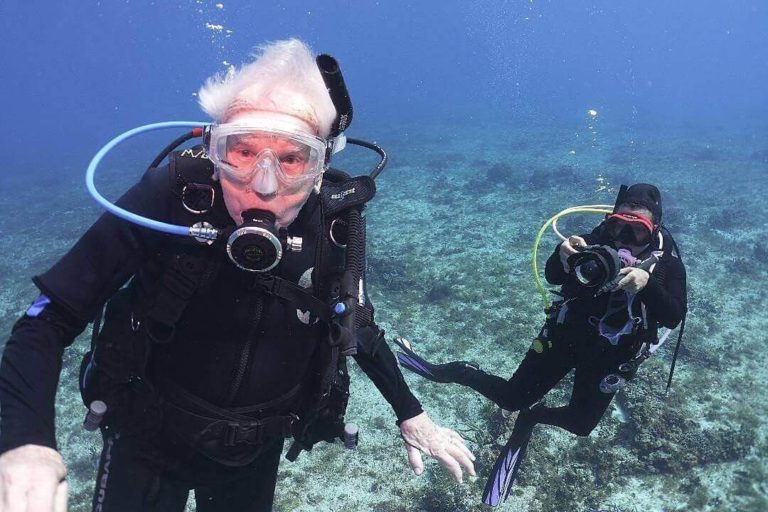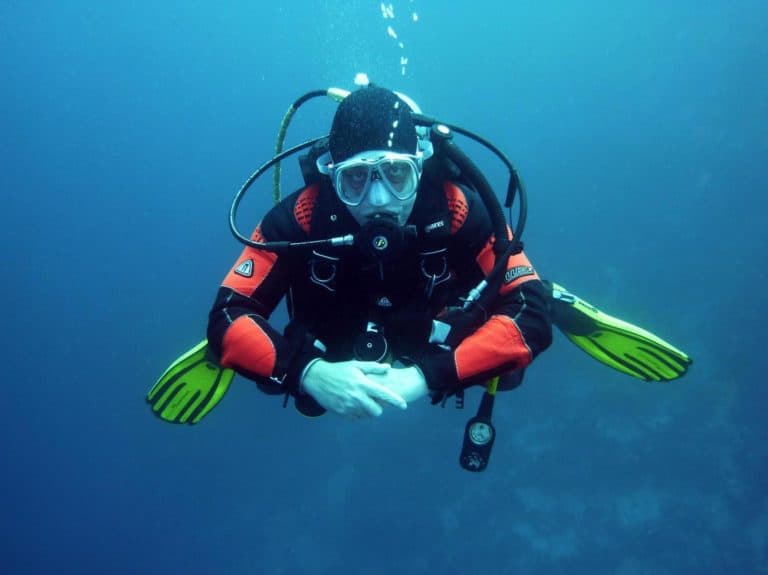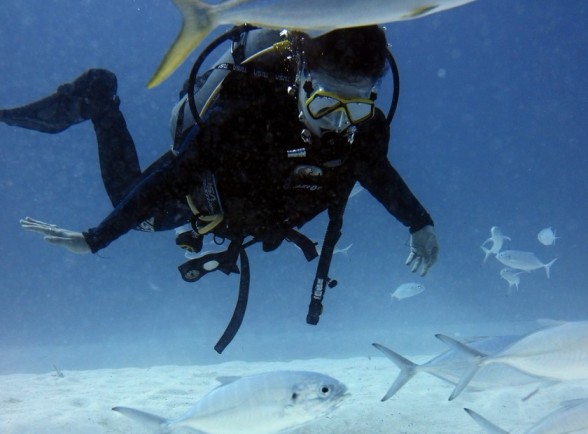How Many Scuba Dives per Day
Maybe you are traveling and want to explore all dive sites in a short period of time or want to log in more dives to hit a goal or requirement for a new certification. Whatever your reason is for wanting to dive more, you may wonder how many scuba dives per day are safe.
Dives per day depend on various factors such as depth, length, and the individuals’ physical fitness and health. The average recreational diver can dive 2-4 times per day as long as they follow the dive computers or tables guidelines.
Seasoned divers can safely dive a maximum of 5 times a day including a night dive. Divers planning on taking multiple dives have to come up with a detailed plan on how or when they plan to dive.
When taking multiple dives in a day, always schedule the deepest dive first.
Dive tables and computers are used as a guide for planning out the dives. These tell you how long you can safely keep diving at certain depths. Today dive computers are widely used by divers since they can keep checking them as they dive.
Many beginners and first-time divers can comfortably take 1-2 dives per day. This is because you are not used to being underwater for long and you get tired quickly.
Other factors that may limit the number of dives per day include feeling hungry, hypothermia, oxygen toxicity, nitrogen build-up in the body tissues, and inability to equalize the ear pressure, among many others. Most of these factors are individualized and may not apply to all divers in a similar manner.
In this article, we’ll look into other aspects of determining how many dives you can make per day or week, and how to safely take multiple dives without risking injuries.
Leets get into it!
How Many Scuba Dives Are Safe In A Day
Technically there is no maximum limit set for the number of dives you can take in a day. This number lies within the individual diver’s abilities.
With this in mind, dive tables and computers can also help plan out how many dives you can safely take in a day since you need to decompress. While some divers claim to take up to six dives per day this may be dangerous as it increases the nitrogen buildup in your body tissues and also increases the chances of injuries.
For those planning on taking multiple dives, it’s always advisable to keep them at shallow depths and also keep them short.
Start with the deepest dive first thing in the morning then take the shallow dives later in the day.
This allows the body to off-gas the excess nitrogen taken up during the deep dives.
The only limit available for the number of dives per day is the 3 training dives recommended by PADI. Besides this, there are no other maximum limits available or set for recreational divers. It all lies within your abilities and safety.
In as much as scuba diving may be fun always remember to keep your safety first. Don’t push your body over the limits of what it can handle. There is no competition on who takes the most dives in a day, always stay safe when planning dives.
How Long Do You Have To Wait Between Dives
To calculate how long you have to wait between dives, dive compression tables and dive computers are your best solution.
These have been developed by teams of experts and professionals to help divers at all levels calculate the time needed before taking the next dive. Extensive research and studies have also been conducted to ensure the dive tables are safe to use even for recreational divers.
Different dive agencies such as (PADI, and NAUI) have their own dive tables available for recreational divers to use.
These use a letter system (A – L) indicating the lowest – highest nitrogen buildup level divers should expect after diving at certain depths for a particular amount of time.
Divers planning on taking multiple dives in a day should most definitely use dive tables and computers.

Use Dive tables
Looking at the NAUI dive tables, these are divided into three categories. End of dive letter group, Surface Interval Time, and Residual Time Table.
The End of dive letter group table tells divers how much nitrogen builds up in the tissues after X amount of time spent diving at a given depth. This table also indicates the time divers should spend at each stop during the ascent.
Surface interval time (SIT) tables on the other hand tell divers how much time they should take before taking the next dive. The minimum rest time according to the tables is 10 minutes but it could be longer depending on the previous dive. The letters are used to indicate how much each diver takes depending on their dive depth and length.
Lastly, residual time tables show the maximum amount of time a diver can spend at one depth. Since the tables are somehow interdependent, the amount of time spent resting may affect your residual time at the next div. more time spent resting can increase your residual time at a given depth and vice versa is true.
Since divers can only take one dive over 100 feet per day, it’s recommended to start with this dive first if planning on diving to these depths.
In such a scenario, the diver will take a longer period ascending, and resting before their next dive. The table’s guidelines will vary depending on how much time is spent diving at a given depth
Can You Dive 3 Days in A Row
The simple answer is yes, you can dive 3 days in a row.
The more in-depth answer is it will depend on multiple factors such as diving depth and length as well diver’s wellbeing.
Divers taking multiple lengthy dives in a day may get exhausted by the second day and not be in a position to go diving the next day. On the other hand, those taking shorter dives in shallow depths can manage to dive 3 days in a row and still be in good shape.
The diver’s well-being also matters a lot since they need the energy to keep diving. Some may not be in a position to stay in water for such lengths without risking going into hypothermia.
Other factors to consider include the other recreational activities planned such as hiking as well as their departure dates.
It’s recommended to rest for at least 18 – 24 hours before flying after diving. This allows the body to off-gas the nitrogen and lowers the chances of decompression sickness.
Activities such as hiking are similar to flying and should be avoided immediately after diving. During a vacation always consider all activities and plan them accordingly throughout the available days.
Lastly, your ability to dive 2 or 3 days in a row will depend on a lot of factors. It’s not limited by a set of policies or rules set for divers. By following the dive tables and computers, and taking shallow dives you can safely dive 3 days in a row.

Can You Scuba Dive Every Day
Unless you are a diving instructor or guide it may be difficult to dive every day or even every week. The average recreational diver has about 8 dives in a year.
Everyday life may limit the number of times you dive.
In addition, your location can also limit the number of dives you take. If you live far away from the dive spots then you have to travel in order to dive which is not always a regular thing for many people.
Divers with access to dive spots can dive every day.
This can actually increase a diver’s confidence in the water, help them log in more dives, and generally improve their diving skills.
When diving every day remember to use dive tables or computers. You don’t have to necessarily take multiple dives if you are diving every day, even once a day can make a huge difference in your skills.
How Many Dives Can You Do In a Week
On average you can dive up to 14 times a week if you do 2 dives per day.
Many divers however may not wish to dish in the same spot every day as it can get boring. If different dive spots are within the same location then it’s possible to take 14 or more dives in a week.
As mentioned above other factors also determine how many dives you can make. Factors such as health, physical fitness, depth, and length of the div.
Remember that more time spent underwater increases the chances of injury to tissues and chances of developing decompression sickness.
While it’s possible to take as many dives as one may want in a week, always consider all other factors and risks involved.
It will also be difficult for divers in very cold regions to dive every day since the weather isn’t very conducive.
Parting Words
We’ve looked at how many scuba dives per day are possible and safe. This number varies depending on the individual and diving conditions.
It is possible to do multiple scuba dives in a day safely for the seasoned diver. First-time divers may only manage to take one dive in a day which is very much okay.
Dive tables and computers guide repetitive divers or those planning on taking multiple dives on how many dives they can make in a single day.
Most importantly, remember to listen to your body and don’t subject it to too much pressure it can’t handle. Multiple dives per day can also increase your chances of developing DCS or other forms of injuries related to scuba diving.
Stay safe and happy diving!







